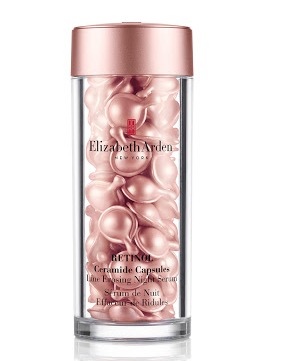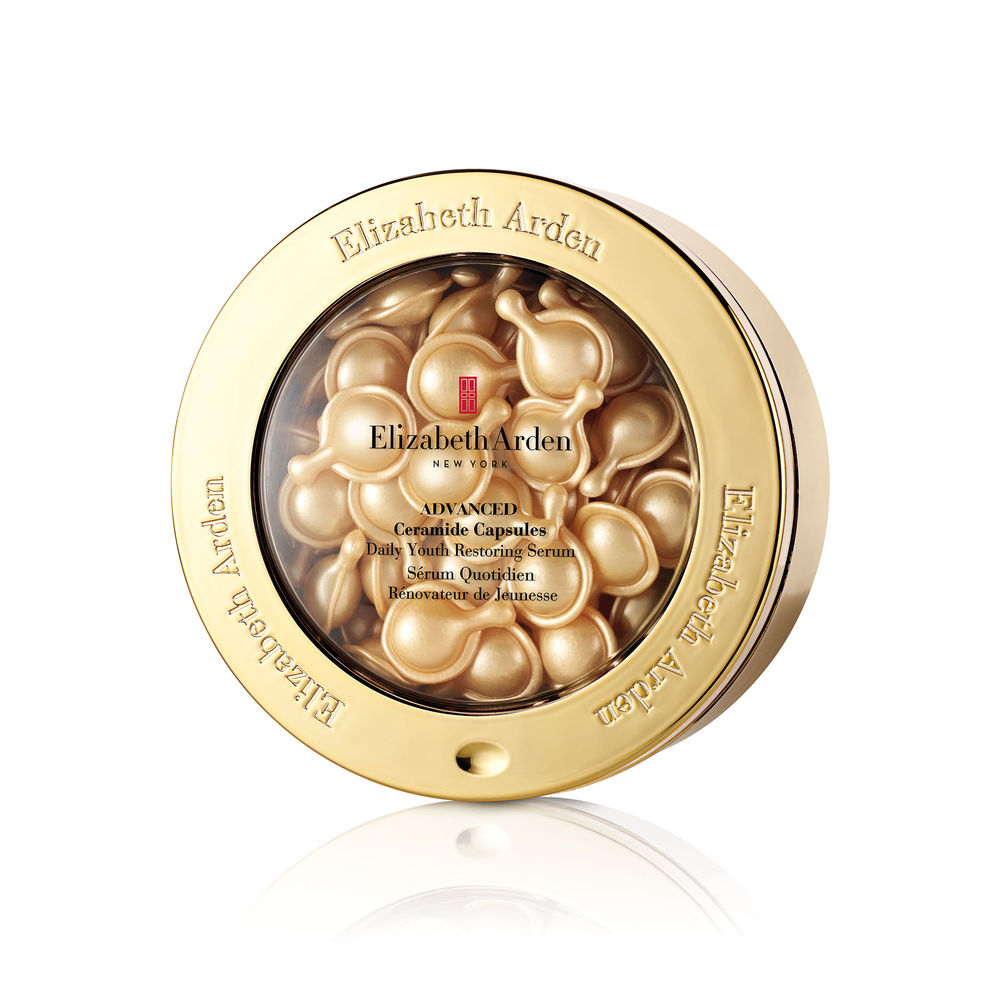

Elizabeth Arden
Retinol Ceramide Capsules
Uploaded on 03/06/2019
76% more potent than unencapsulated retinol --a new, targeted treatment
to visibly diminish lines and wrinkles while improving skin texture and tone. Each capsule is single-use and sealed tight for optimal freshness and potency. Plus, they are preservative and fragrance free. Smooth over face and neck each night before your moisturizer. Suitable for all skin types. Clinically and dermatologist tested.
Elizabeth Arden
Advanced Ceramide Capsules Daily Youth Restoring Serum
Uploaded on 05/07/2018
Anti-aging serum in capsule form
Ingredients
| what‑it‑does | emollient |
An emollient ester with a rich and creamy but non-greasy skin feel.
[more]
| what‑it‑does | emollient |
A low molecular weight dry, silky emollient ester that gives a light and non-greasy feel to the formulas.
[more]
| what‑it‑does | emollient | solvent |
A clear, colorless and odorless, highly volatile (meaning it does not absorb into the skin but evaporates from it) liquid that's used as an emollient and gives a nice, non-oily light skin-feel.
[more]
| what‑it‑does | emollient | perfuming |
| irritancy, com. | 3, 3-5 |
A clear, colorless oil-like liquid that's used as a fast-spreading, non-greasy emollient.
[more]
| what‑it‑does | emollient |
| irritancy, com. | 0, 1 |
A very common silicone that gives both skin and hair a silky smooth feel. It also forms a protective barrier on the skin and fills in fine lines. Also used for scar treatment.
[more]
| what‑it‑does | emollient |
| what‑it‑does | viscosity controlling |
| what‑it‑does | emollient |
A very common emollient that makes your skin feel nice and smooth. Comes from coconut oil and glycerin, it’s light-textured, clear, odorless and non-greasy.
[more]
| what‑it‑does | emollient | solvent |
It's a super commonly used water-thin volatile silicone that gives skin and hair a silky, smooth feel.
[more]
| what‑it‑does | skin-identical ingredient |
Ceramides get quite a lot of hype recently and good news: there is a reason for that. But before we go into the details, let's just quickly define what the heck ceramides are:
They are waxy lipids that can be found naturally in the outer layer of the skin (called stratum corneum - SC).
[more]
| what‑it‑does | skin-identical ingredient |
Ceramides make up 50% of the goopy stuff that's between our skin cells and play a super important role in having a healthy skin barrier and keeping the skin hydrated.
[more]
| what‑it‑does | skin-identical ingredient |
A type of ceramide that can be found naturally in the upper layer of the skin. Ceramides make up 50% of the goopy stuff that's between our skin cells and play a super important role in having a healthy skin barrier and keeping the skin hydrated.
We have written way more about ceramides at ceramide 1, so click here to know more.
[more]
| what‑it‑does | skin-identical ingredient | emollient |
| irritancy, com. | 0, 0 |
It's one of the important lipids that can be found naturally in the outer layer of the skin. About 25% of the goopy stuff between our skin cells consists of cholesterol.
[more]
| what‑it‑does | emollient | perfuming |
| irritancy, com. | 0, 4 |
There is definitely some craze going on for coconut oil both in the healthy eating space (often claimed to be the healthiest oil to cook with but this is a topic for another site) and in the skin and hair care space. We will talk here about the latter two and see why we might want to smear it all over ourselves.
[more]
| what‑it‑does | emollient | moisturizer/humectant |
A thick, high molecular weight silicone that is usually diluted in a lighter silicone fluid. The dimethiconol containing silicone blends leave a silky smooth, non-greasy film on the skin.
[more]
| what‑it‑does | emollient | emulsifying |
It's quite the multi-tasker: an emollient and water-binding ingredient but also an emulsifier and can be used for stabilization purposes. It's also often used to create liposomes.
[more]
| what‑it‑does | skin-identical ingredient | emollient | surfactant/cleansing |
The famous omega-6 fatty acid, the mother of all ω-6 fatty acids in our body. It is a so-called polyunsaturated fatty acid meaning it has more than one (in this case two) double bonds and a somewhat kinky structure that makes LA and LA-rich oils a thin liquid.It is also an essential fatty acid meaning our body cannot synthesize
[more]
| what‑it‑does | skin-identical ingredient | emollient | surfactant/cleansing | perfuming |
The famous omega-3 fatty acid, the mother of all ω-3 fatty acids in our body. Next to linoleic acid, it is the other essential fatty acid that our body cannot synthesize and we have to ingest it from our food.
[more]
| what‑it‑does | skin-identical ingredient | cell-communicating ingredient | anti-acne | antimicrobial/antibacterial |
A type of lipid that can be found naturally in the skin. Has antimicrobial and cell-communicating properties and is considered to be part of the skin's natural defence system.
[more]
| what‑it‑does | cell-communicating ingredient |
| irritancy, com. | 1-3, 1-3 |
An ester form of vitamin A (retinol + palmitic acid) that is pretty much the least effective member of the retinoid family. Its anti-aging effects are quite questionable as well as its behavior in the presence of UVA light. (Use it at night if possible!)
[more]
| what‑it‑does | skin-identical ingredient | antioxidant | emollient |
Squalene is an oily liquid that originally comes from shark liver but luckily it can also be found in a couple of plant oils. Olive (0.6%), peanut (0.1%) and pumpkin (0.35%) oils contain it, though not in huge amounts. What contains more of it, is the sebum (the oily stuff) that our skin produces.
[more]
| what‑it‑does | antioxidant |
| irritancy, com. | 0-3, 0-3 |
Pure Vitamin E. Great antioxidant that gives significant photoprotection against UVB rays. Works in synergy with Vitamin C.
[more]
| what‑it‑does | viscosity controlling |
A high-molecular-weight silicone elastomer (rubber-like elastic material) that is usually blended with a base silicone fluid (such as dimethicone or cyclopentasiloxane) to give the formula a silky smooth feel and to act as a thickening agent.
[more]
| what‑it‑does | emollient | antimicrobial/antibacterial |
An often used emollient with a light and silky feel. It's very mild to both skin and eyes and spreads nicely and easily. It's often used in sunscreens as it's also an excellent solvent for sunscreen agents.
| what‑it‑does | antioxidant | preservative |
It's the acronym for Butylated Hydroxy Toluene. It's a common synthetic antioxidant that's used as a preservative.There is some controversy around BHT.
[more]
| what‑it‑does | emollient |
| what‑it‑does | antioxidant | soothing |
Green Tea - one of the most researched natural ingredients that contains the superstar actives called catechins. It has proven antioxidant, anti-inflammatory, antimicrobial and anticarcinogenic properties.
[more]
| what‑it‑does | skin-identical ingredient |
| what‑it‑does | emollient | solvent |
A light-feeling, volatile silicone that gives skin a unique, silky and non-greasy feel. It has excellent spreading properties and leaves no oily residue or build-up.
| what‑it‑does | emollient |
| what‑it‑does | emollient |
| irritancy, com. | 0, 0 |
Sunflower Oil - it's a great emollient that protects & enhances the skin barrier.
[more]
| what‑it‑does | antioxidant | emollient |
| irritancy, com. | 0, 0-2 |
Olive oil - an oleic acid-rich (55-83%) emollient plant oil that can moisturize dry skin. Also, it contains antioxidant polyphenols and vitamin E.
[more]
| what‑it‑does | cell-communicating ingredient |
The pal of Palmitoyl Tripeptide-1 in Matrixyl 3000. A four amino acid peptide that works by reducing the production of the signal molecule, inteleukin-6 (IL-6) that promotes inflammation in the skin.
[more]
| what‑it‑does | cell-communicating ingredient |
A three amino acid peptide that is part of famous peptide duo, Matrixyl 3000. It's a type I collagen fragment that might be able to trick the skin to think that collagen broke down and it's time to create some new one.
[more]
| what‑it‑does | antioxidant | emollient |
| irritancy, com. | 0, 0-3 |
Avocado oil - a highly moisturizing, rich emollient oil that is loaded with fatty acids (oleic - 70%) and vitamin A, E and D.
[more]
| what‑it‑does | emulsifying | surfactant/cleansing |
| irritancy, com. | 0, 0 |
It's a common little helper ingredient that helps water and oil to mix together. Also, it can help to increase the solubility of some other ingredients in the formula.
| what‑it‑does | emollient |
| irritancy, com. | 0, 1 |
An emollient that leaves a light, non-oily smooth and velvet skin sensation. Also great at dispersing and dissolving pigments and sunscreen actives.
[more]
| what‑it‑does | cell-communicating ingredient |
Vitamin A - the most proven anti-aging ingredient available OTC that can smooth wrinkles and make skin firmer. It might also be useful for acne-prone skin as it normalizes keratinization.
[more]
| what‑it‑does | emulsifying |
| irritancy, com. | 1-2, 1-2 |
An ingredient that helps water and oil to mix together, aka emulsifier. Chemically speaking, it comes from the attachment of sorbitan (a dehydrated sorbitol (sugar) molecule) with the fatty acid Lauric Acid, that creates a partly water (the sorbitan part) and partly oil soluble (lauric part) molecule.
Sorbitan Laurate is a good team player that likes to work with many other emulsifiers and
[more]
| what‑it‑does | antioxidant | skin brightening | soothing |
Part of a trio called Tetrahydrocurcuminoids, that is a standardized powdered extract from the roots of the Curcuma longa (Turmeric). Has skin-brightening, anti-inflammatory and antioxidant magic properties.
[more]
| what‑it‑does | preservative |
Pretty much the current IT-preservative. It’s safe and gentle, and can be used up to 1% worldwide.
[more]





